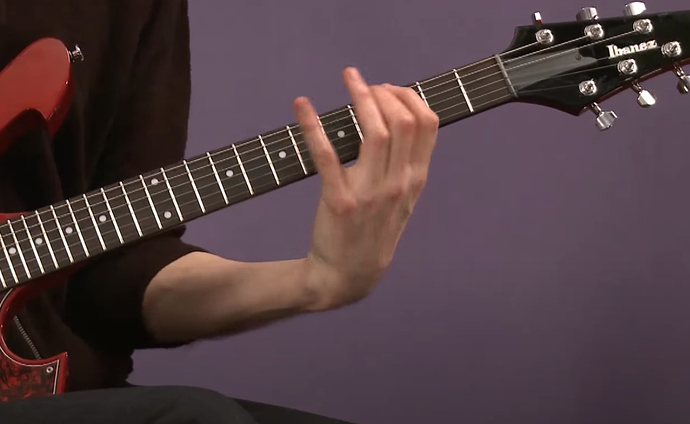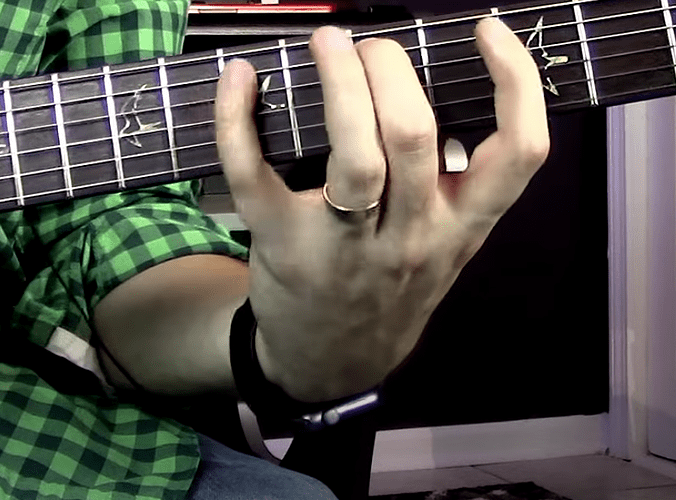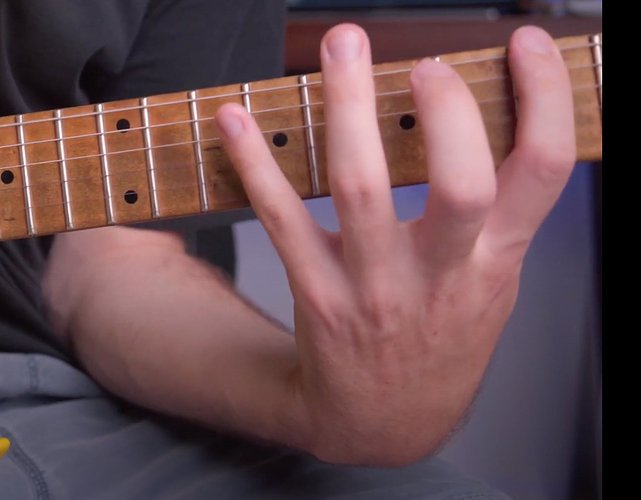Video response to @meepmeep, who sent me some videos privately.
So I reached a new goal with my single string tremolo picking last night. Can almost do 200bpm, but I’d say my comfort zone was 197bpm. Thats a ridiculous goal I never thought I’d reach.
But alas… applying the motion to more then 1 string is still the absolute biggest struggle. I reached my goal using USX (downward pickslant).
Congratulations, regardless of your current new blockers that’s a big step. I can do 200 bpm as well single string, and am working on changing strings. I haven’t clocked it yet but it’s miles better than it was – will post at some point with some steps I followed to get there. As always, experiment, and stay loose. Cheers! jz
Can we get a video of this? If a motion that is this fast cannot change strings, I’d suspect it’s either:
- Trapped; OR
- Not the same motion when you reach this speed as you’re using when you put the hands together
For the latter, one thing that helped me a lot was playing “tremolo melodies” that stay on one string. Somehow I’d realized my motion was in fact changing when I attempted to play actual music with my newly learned fast motion. It’s like the “rub your belly and scratch your head at the same time issue” where you have to make sure the hands can be independent of each other. Once that picking hand just turns into a motor that keeps going on its own, great things can start happening  Without a video of seeing what you’re doing though, this advice is a shot in the dark and possibly not even helpful.
Without a video of seeing what you’re doing though, this advice is a shot in the dark and possibly not even helpful.
Congratulations on the new speed though and best of luck on the path forward!
Thank you!
Thank you!
Unfortunately i hurt my hand this morning… so no videos for a while haha. Do you have any tremolo melodies you can share with me?
Sorry about the hand hurting incident 
For tremolo melodies, I think I may have played part of the prechorus in “A Bid Farewell” by Killswitch Engage.
I feel like maybe I played some Thunderstruck by AC/DC, just not doing any open strings so that the fretting hand could be a little more “stupid” lol. I do know that it wasn’t anything I made a routine of, just anything that’s a simple melody or it can be improvised is fine too.
I also recall that once I cemented this and started trying to move it across the strings (while still tremolo-ing) that I started by trying to play the melody of Edelweiss from the Sound of Music. Christopher Plummer had just passed so I thought it could be my own little tribute to a national treasure. Once you start moving the tremolo to different strings, just beware of your escape strategy. If you are DSX you’ll be in for trouble unless you begin on an upstroke! The melodies tend to change strings on the beats, or even on the 8th note and the only way you can do that with DSX is to start with an upstroke.
Thanks! I will have to check this out.
Also, this has been a very helpful lesson for anyone who hasn’t seen it.
Tom I’ve watched your video about 20 times now and i’m FINALLY getting the hang of things. As I stated earlier in the thread I did injure my hand so videos are out of the question, but I just wanted to tap back in with an update.
Truly appreciate your help and insight!
Here is what I did to practice fast tremolo with string changes:
A variation of spider exercise.
After each repetition go one fret up.
Now after this point everything I write relates to me - might not be most suitable for you, but let’s try anyways:
-
position - I did not notice anyone asking nor you mentioning in what position are you sitting while praticing. For me it’s classical - guitar on my left lap, neck at a pretty steep angle.
Why - beacause it helps me keep both arms relaxed. Left hand wrist at optimal angle, good grasp of the neck, right hand relaxed and precise. -
picking motion - for starters, I don’t use elbow motion, at least not on it’s own. I’d invite someone more knowledgeable to see and describe what exactly am I doing - but for now let’s say I use forearm rotation with my righ (picking) wrist slightly bent. Pick attack is never completely flat for me, it’s always angled a bit and I found that the more the angle, the faster I can pick with less motion (may not be entirely correct on this one though, but that’s how I perceive it at the moment).
I used to pick so that the pick would point downwards, which frankly turned out to be stupid for straight 16th note tremolo picking with string changes happening on downbeats.
I discovered it while trying to play Rotting Christ’s Kata ton Daimona Eaytoy.
I turned my technique 180 then, with point of the pick pointing upwards ever since.
Of course, further down it turns to be not so smart to stick to just one, but rather a combination depending on what you need (i.e. when you change the string), but for now we are doing even numbers of pick strokes per string, aren’t we.
- As for left hand - I’d say classical position should enforce the correct wrist angle on it’s own, with inside of your palm facing towards you.
Try not to have your thumb rest on the upper edge of the neck.
I see you mentioned not being able to pull your ring finger away from middle finger - this should help:
The first couple of exercises, just after the initial warm-up.
Hello it’s me again.
I don’t know if it’s because it’s late or because i’m stupid… but I just can’t seem to wrap my head around “keeping the wrist straight” when I play 3nps. Especially on the lower strings. Then I get super analytical about it and try and keep my wrist straight but I just can’t do it. So I hop on youtube to try and find that magic video and see everyone else in the world bending their wrist. I see everyone standing the same way I do… I see everyone sitting the same way I do. But technically how I play is not “correct”.
Gahhhh… any replies are appreciated.
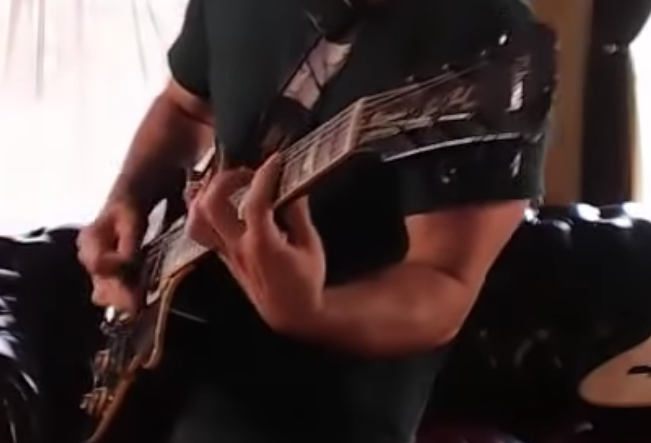
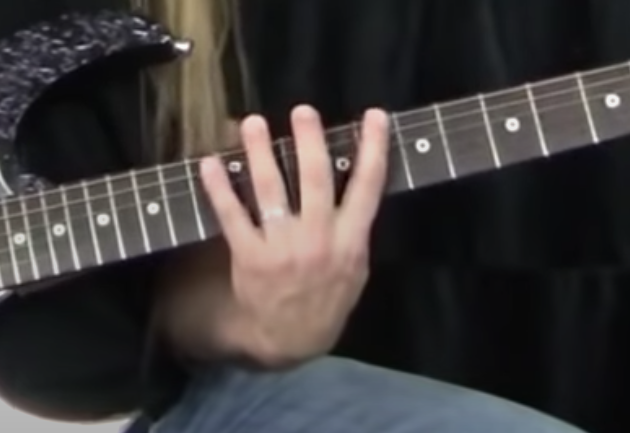
Indeed, it is sometimes inevitable to bend the wrist a little, especially on the lower strings. Of the pictures you posted, the last two seem the most injury-prone. But I would assume these players would also go back to straight wrist as soon as they can.
But the idea is to go back to straight wrist as soon as possible.
Edit: @Tom_Gilroy is the most knowledgeable person I know RE: fretting technique. Maybe he has more precise comments about the four snapshots you just posted.
First 3 pictures look alright, last 2 not as ergonomic but the second to last the person looks like they’re demonstrating something, not actually playing.
Anyways I never bought into the “wrist must always be straight” mantra. The guitarists I looked up to bend their wrists, the dudes I grew up with do it, I do it. The only guitarists I can think of that follow that most of the time are classical guys.
My guess is that your wrist pain is coming from too much fretting pressure. You could check this yourself:
- Place a finger on a fret as if you’re about to play a note, but without any pressure.
- Start picking the string, it should sound muted / choked (since you’re not fully fretting).
- Slowly press down on the fret until it starts to actually sound the note. This is the minimum fret pressure required.
If you find that this is much less pressure than you’re used to, then I think you’ve found the issue. Assuming that your guitar has a good setup with “forgiving” string tension, you don’t need much pressure as all.
In this picture, Paul’s elbow is close to his body and his hand is low in th eneck to due external rotation of the shoulder. Notice the natural curve of the index finger and how the tip of his index finger points to his chin. Notice how the fingernail of the first finger points toward the nut, indicating that Paul is fretting somewhat with the side of his index finger. Though not in view, his thumb is close to his index finger and notdrawn hard into opposition.
The bend is not severe and there is no hyperextension of the fingers. This is fine.
In this picture, Troy’s elbow is again close to his body. The guitar hangs under his picking arm so less external rotation in the shoulder of the fretting arm is required. Notice that the index finger is more extended and points more inline with the fret. Notice that the fingernail of that index finger points out from the fretboard and that Troy is clearly fretting with the flat of the index finger. The thumb is near the index finger and not drawn hard into opposition.
The wrist is flexed but I see no indication that it’s under torsion. This could very well be a comfortable wrist position depending on your personal range of motion. Notice however that there is hyperextension at the MCP joint of the ring finger. This is indicates the presence of extensor tension.
I wouldn’t say this is ideal, but it’s certainly not bad.
I believe this is Ben Eller?
Notice that the elbow is again close to the body. The guitar is on the right leg so there is less external rotation of the fretting arm shoulder. Notice that the index finger is neither pointing to the chin nor pointing inliine with the frets. Notice that the fingernail of the index finger is pointing soomewhat twoard the nut and that the string is being fretting somewaht with the side of the index finger.
The degree of flexion in the wrist is not severe, however we can see that the wrist is clearly ulnar deviated, and there is torsion. The thumb is drawn hard into opposition with the middle finger. The separation between the fingers is coming almost purely from abduction of the fingers, and we can see that the fretting position of the index finger is not particularly good.
This probably functional, but it could be much better.
I don’t believe this is a functional fretting posture.
The degree of flexion in the the wrist is severe and the wrist is under ulnar deviation creating torsion. The thumb is drawn hard into opposition. The fingers are out of position for frettting and fretting with the 2nd or 3rd finger would require hyperextension at the MCP joints. All finger separation is through abduction.
I suspect that the player in this picture alters their posture when actually playing, but this form is definitely to be avoided. Also, I would recommend against using this player’s form as a template or model for imitation.
Unlike the previous image, I believe this is this player’s actual fretting posture.
There’s no way to say this nicely. This is bad.
The guitar is on the players right leg, but the degree of external rotation in their fretting arm shoulder is extreme. The degree of flexion in the wrist is severe and the wrist is deviated, so the wrist is under torsion. The thumb, while not in view, appears to be drawn hard into opposition. All finger separation is due to abduction and there is hyperextension at the knuckle of the 2nd finger.
@Pepepicks66 's fretting pressure exercise is great, do that. I believe that Paul Graham has recommended starting all practice sessions with that, to remind your body just how little work it needs to do when fretting.
Another super exercise I found recently is this, which I find quite calming for my mind and left hand – no picking required, just purposefully and effortlessly fretting notes, one finger at a time:
Cheers! z
Oh wow - your picking hand here is almost identical to how mine is now. I had to kind of knuckle down and really sus out a vocabulary that worked for me, and it really required that I pay attention to what works and what doesn’t, and then come up with a strategy for dealing with the things that don’t quite work “as written”. Gotta re-arrange those notes sometimes…
I am having the same issue only with my left hand (fretting). Are there any videos here that take on this issue? For some reason I have not ever developed “shredder” speed. I’ve been playing for 43 years but haven’t been working on speed but for about a decade. There is s lick that Doug Aldrich does that I call his “money” lick. You can see it in the Betcha Can’t Play This video. Essentially, it is a six note, two string pentatonic like where, for instance, if you are playing in Emin Pentatonic position one at the twelth fret, you hammer on from 12 to 15 on the 3rd string and then pick twelve/fifteen on the 2nd string, pull off from 15 to 12, and ghost hammer on (not picking) 15 on the 3rd string, and pull off to 12 and repeat. For me, this is extremely difficult when I reach about 90 BPM or above. I tried to tap the BPM while he was playing it in the video and he is doing it at around 150 BPM. SMH! How does he do that?
I also experience pick tracking problems with scales, or those Eric Johnson 5s or 6s pentatonic runs. Any suggestions would be very appreciated!
Hello again,
Could somebody please help me/give me advice on thumb behind the neck/bent wrist for 3nps scale patterns? I feel so pathetic that I still can’t get the hang of it/keep having pain in my wrist. My thumb always (no matter how hard I try) digs into the back of the neck which causes my palm to cramp. My fingers curl too much and I just can’t play anything.
@meepmeep I made a video of me doing a 3nps pattern across the neck (there’s a 2nps portion in there I’m experimenting with but whatever) from different angles so you can see my wrist. Maybe you could record something similar so we have better views of your fretting hand?







